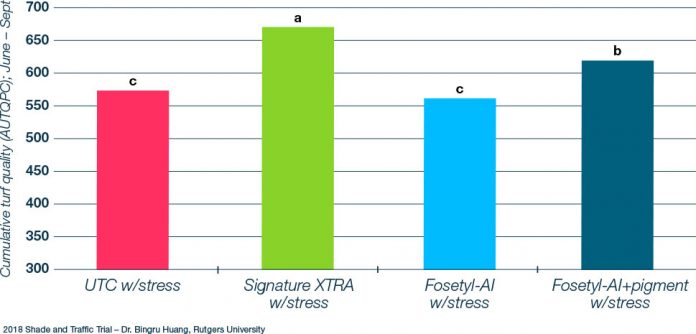
Summer’s here, and it brings the toughest time for golf courses – and superintendents – across the country. For many, the tolls of summer stress on turf are already apparent. Whether general chlorosis, poor vigor, reduced density, diminished root systems, increased disease activity or overall inferior turf quality, the symptoms of stress won’t let up anytime soon.
Most superintendents take the necessary steps months in advance to protect and prepare turf from summer heat, drought, and the most difficult to manage stresses like shade and traffic. However, even the best preparation can’t fully prevent the inevitable effects of biotic and abiotic stress.
So how do you manage the stress once it’s arrived? The good news is, it’s not too late.
// Cultural Practices
There are several cultural tactics that help mitigate the most challenging mid-summer stressors. Encouraging sufficient air movement by pruning/removing trees and installing/using fans, spoon feeding nutrition, reducing moisture extremes (too wet or too dry), and directing foot and mechanical traffic away from vulnerable areas can all help mitigate abiotic stress.
There are also measures that can help turf bounce back faster. These include raising the height of cut and alternating mowing and rolling to accomplish the effective increase in mowing height while still maintaining green speeds. Raising mowing height is one of the single most helpful strategies for improving turf quality by encouraging more leaf surface area to drive photosynthesis, carbon metabolism, cellular development and root growth.
// More Than Disease Management
Most turf diseases are opportunists that take advantage of a compromised plant. Disease can often be the “final straw” that takes a stressed plant to the point of no return. A robust, preventive fungicide program that covers the bases of both fungal and oomycete pathogens can help combat disease and ensure better survival during times of elevated stress.
However, in the brutal heat of summer, superintendents need more than disease management. Stressgard® fungicides from Bayer deliver benefits that extend well beyond disease control, as they’re specifically designed to increase turf’s tolerance to, and recovery from:
- Heat
- Drought
- Traffic
- Shade issues and light quality
- Oxidative stress
These benefits are evident in recent research on heavy shade and traffic stresses. The research, conducted by Dr. Bingru Huang at Rutgers University, studied the impact of Signature™ XTRA Stressgard from Bayer, with includes the active ingredient (ai) fosetyl-Al. Over the course of 3 months, when compared to the ai alone (C), the ai with pigment (B) and untreated control (C), Signature XTRA Stressgard (A) resulted in significantly improved turf quality under high-stress periods.

// The Bottom Line
An ounce of prevention is worth a pound of cure. The best way to combat summer stress is to implement cultural and chemical practices aimed at improving root growth and photosynthesis throughout the year.
Combined with the versatility, consistency and satisfaction that Stressgard brings, superintendents can feel confident their turf can survive the dog days of summer. That may mean less hand watering or lower run times, less scouting or babysitting problem areas, a higher comfort level when using plant growth regulators, greater peace of mind during heavy periods of play, and more time to do things other than worrying about summer turf stress. Bottom line: your summer just got better with Stressgard.
For additional guidance, visit es.bayer.us/Stressgard











